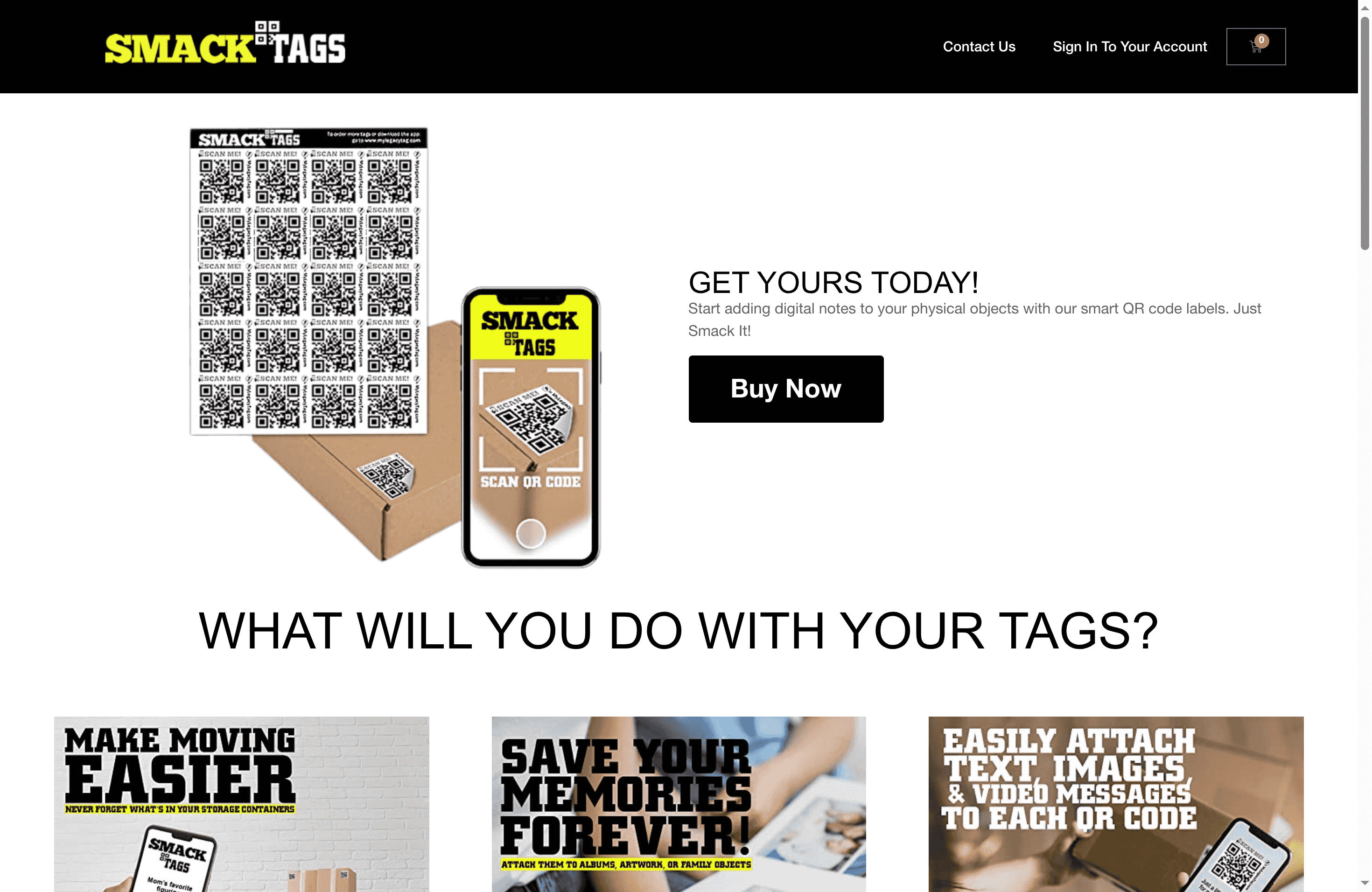What Are Smart Labels? Complete Guide to Uses
More than 60 percent of businesses use smart labels to track products and manage inventory with speed and accuracy. These advanced digital tags are changing how we connect with everyday objects, from shopping and shipping to art and collectibles. Whether you want to cut down on paperwork or add digital memories to handmade items, learning about smart labels can help you turn ordinary labels into powerful sources of information and creativity.
Table of Contents
- What Are Smart Labels? Core Definition And Uses
- Types Of Smart Labels And Qr Stickers
- How Smart Labels Work: Features Explained
- Real-World Applications For Personal And Business
- Benefits, Costs, And Subscription Considerations
- Important Safety And Privacy Factors
Key Takeaways
| Point | Details |
|---|---|
| Definition of Smart Labels | Smart labels are digital identifiers using technologies like QR codes and RFID tags to enhance product information and tracking. |
| Core Applications | They are widely used in inventory management, product authentication, information sharing, and asset tracking across various industries. |
| Privacy and Safety Concerns | Smart labels raise privacy issues, particularly with RFID technology, necessitating secure data practices and user consent. |
| Investment Considerations | Implementing smart labels involves initial costs, system compatibility concerns, and managing privacy implications for effective usage. |
What Are Smart Labels? Core Definition and Uses
Smart labels are advanced digital identifiers that transform traditional product tags into interactive information portals. According to EBSCO Research, these sophisticated labels integrate technologies like QR codes and RFID tags to provide detailed information far beyond conventional printed labels.
At their core, smart labels are sophisticated tracking and information systems embedded within standard label formats. Wikipedia defines them as flat transponders containing a chip, antenna, and bonding wires that enable automated reading from a specified distance. This technological integration allows for seamless data transmission across multiple industries including retail, logistics, healthcare, and library management.
The primary uses of smart labels span several critical applications:
- Inventory Management: Instantly track product locations and quantities
- Product Authentication: Verify genuine items and prevent counterfeiting
- Information Sharing: Provide comprehensive product details via digital scanning
- Asset Tracking: Monitor equipment, documents, and valuable items
For artists and crafters, smart labels offer unique opportunities to preserve stories and memories. By attaching digital content to physical objects, creators can document the journey of their work, share production techniques, or create interactive experiences for viewers.
 These labels essentially transform static items into dynamic storytelling platforms.
These labels essentially transform static items into dynamic storytelling platforms.
With their ability to store text, images, videos, and additional metadata, smart labels are revolutionizing how we interact with and understand physical objects across personal and professional domains. Our guide on why use scannable labels provides even more insights into maximizing these innovative tracking solutions.
Types of Smart Labels and QR Stickers
Smart labels represent a diverse technological ecosystem with multiple innovative designs tailored to specific tracking and information needs. Wikipedia identifies three primary categories of smart labels: chip labels, printable labels, and electronic labels, each offering unique capabilities for different applications.
Chip labels, particularly those integrating RFID technology, enable advanced tracking and authentication processes. More sophisticated iterations include groundbreaking security features. According to ArXiv Research, some cutting-edge smart labels now incorporate anti-counterfeiting technologies like camouflaged QR codes embedded in nanocavities using polymer-dispersed liquid crystals. These advanced tags remain invisible under normal conditions and become readable only under specific thermal conditions.
The primary types of smart labels include:
- RFID Chip Labels: Provide real-time tracking and inventory management
- Printable Transistor Labels: Enable data collection through printed electronic components
- QR Code Labels: Offer quick digital information access via smartphone scanning
- NFC-Enabled Labels: Allow proximity-based data exchange
For artists and crafters, QR stickers present extraordinary opportunities to transform physical objects into interactive storytelling platforms. By embedding digital content directly into labels, creators can share production techniques, document creative journeys, or provide immersive experiences for audiences.
![]()
Our comprehensive guide to organizing with QR codes offers deeper insights into maximizing these innovative labeling technologies across personal and professional domains.
How Smart Labels Work: Features Explained
Smart labels are sophisticated digital identification systems that transform traditional product tracking through innovative technological integration. According to EBSCO Research, these advanced labels embed technologies like QR codes and RFID tags into product packaging, enabling comprehensive data storage and transmission capabilities.
Wikipedia explains that smart labels function by integrating critical components such as microchips, antennas, and specialized transistors within traditional label formats. These embedded technologies facilitate automated reading and data transmission across various industries, revolutionizing how we track, authenticate, and interact with physical objects.
The core functional features of smart labels include:
- Automated Data Transmission: Instant information sharing without manual input
- Remote Scanning: Ability to read data from a specified distance
- Multi-Format Storage: Capacity to hold text, images, videos, and metadata
- Secure Authentication: Built-in anti-counterfeiting mechanisms
For artists and crafters, these technological marvels offer unprecedented ways to document and share the stories behind their creations. By embedding digital narratives directly into physical labels, creators can provide immersive experiences that extend far beyond traditional product documentation.
Our step-by-step guide to storage labeling provides additional insights into maximizing the potential of these innovative tracking technologies across personal and professional domains.
Real-World Applications for Personal and Business
EBSCO Research reveals that smart labels are transforming operational efficiency across multiple industries, from retail and logistics to healthcare and library management. These innovative digital identifiers enable real-time tracking, inventory management, and comprehensive data collection that revolutionize how organizations monitor and manage assets.
In the realm of product authentication, ArXiv Research highlights groundbreaking applications of smart labels, particularly in anti-counterfeiting efforts. Advanced smart labels with camouflaged QR codes embedded in nanocavities provide secure verification methods for high-value products, especially in sensitive industries like pharmaceuticals and luxury goods.
Diverse applications of smart labels span multiple domains:
- Retail: Precise inventory tracking and management
- Logistics: Real-time shipment monitoring and verification
- Healthcare: Patient tracking and medical equipment management
- Libraries: Book inventory and borrowing system tracking
- Personal Collections: Documenting art, family heirlooms, and personal inventories
For artists and crafters, smart labels offer unprecedented opportunities to document creative processes, authenticate original works, and create interactive experiences that extend beyond traditional product documentation. By embedding digital narratives directly into physical items, creators can share their stories in ways never before possible.
Our comprehensive guide to QR codes in business provides deeper insights into how these innovative technologies are transforming professional and personal tracking methods.
Benefits, Costs, and Subscription Considerations
According to EBSCO Research, smart labels offer significant advantages including enhanced inventory management, improved tracking capabilities, and increased consumer engagement through detailed product information. These technological solutions provide transformative benefits that extend far beyond traditional labeling methods.
Wikipedia highlights that while smart labels improve efficiency, they also present nuanced challenges such as higher implementation costs and potential mechanical vulnerabilities. The integration of advanced technologies like RFID requires careful engineering to balance technological benefits with practical implementation efforts.
Key considerations for smart label adoption include:
- Initial Investment: Upfront costs for technology and infrastructure
- Compatibility: Ensuring systems can read and process smart label data
- Privacy Implications: Managing data collection and storage protocols
- Technical Complexity: Required training and technological understanding
- Long-Term Value: Potential savings through improved tracking and management
For artists and crafters, the subscription model offers an accessible entry point to these innovative tracking technologies. By providing a low-cost monthly option, creators can experiment with digital storytelling and asset documentation without significant financial risk.
Our guide to QR codes in business provides additional insights into navigating the practical considerations of implementing smart label technologies across different professional and personal contexts.
Important Safety and Privacy Factors
EBSCO Research highlights critical privacy concerns surrounding smart label technologies, particularly with RFID tags that can be easily scanned from a distance. These advanced digital identifiers create potential vulnerabilities where unauthorized individuals might access sensitive information without direct interaction.
Wikipedia further emphasizes that smart labels incorporating RFID technology present unique safety challenges due to their ability to transmit data without requiring direct line-of-sight scanning. This technological capability necessitates robust security measures to protect user information and prevent potential data breaches.
Key privacy and safety considerations include:
- Unauthorized Data Access: Preventing remote scanning of sensitive information
- Data Encryption: Implementing strong protective protocols
- User Consent: Ensuring transparent data collection practices
- Limited Information Exposure: Controlling what data is embedded in labels
- Secure Transmission: Protecting data during digital transfers
For artists and crafters, understanding these privacy dynamics becomes crucial when documenting personal collections or sharing creative narratives. Careful management of digital content can help mitigate potential risks while maintaining the innovative storytelling potential of smart labels.
Our comprehensive guide to QR codes in business offers additional strategies for maintaining digital security while leveraging these powerful technological tools.
Bring Smart Labels to Life with Smack Tags
The challenge with smart labels is turning complex tracking and digital storytelling into something simple and personal. Whether you want to easily preserve memories or improve your storage system these innovative QR code labels make it effortless. You can attach videos, images, and text directly to any item without needing an app. This turns everyday objects into interactive keepsakes or efficient business tools.

Discover how Creative – Smack Tags empowers you to transform your belongings into engaging stories or well-organized assets. Our durable, tear-resistant, and water-resistant QR code labels come with a cost-effective subscription that keeps your digital content safe long term. Don’t wait to make smart labeling a seamless part of your life and work. Explore the possibilities now at Smack Tags and step into the future of smart labels with ease.
Frequently Asked Questions
What are smart labels and how do they work?
Smart labels are advanced digital identifiers that integrate technologies like QR codes and RFID tags into traditional product packaging, enabling automated reading and seamless data transmission for various applications such as inventory management and product authentication.
What are the main types of smart labels?
The primary types of smart labels include RFID chip labels, printable transistor labels, QR code labels, and NFC-enabled labels, each offering distinct capabilities for tracking and information sharing.
How can smart labels be utilized in personal projects?
Smart labels can be used by artists and crafters to embed digital content into physical items, allowing them to document their creative processes, share techniques, and create interactive experiences for viewers.
What are the safety and privacy concerns associated with smart labels?
Safety and privacy concerns include unauthorized data access due to the remote scanning capabilities of RFID tags, necessitating strong data encryption, user consent for data collection, and controlled exposure of embedded information.
